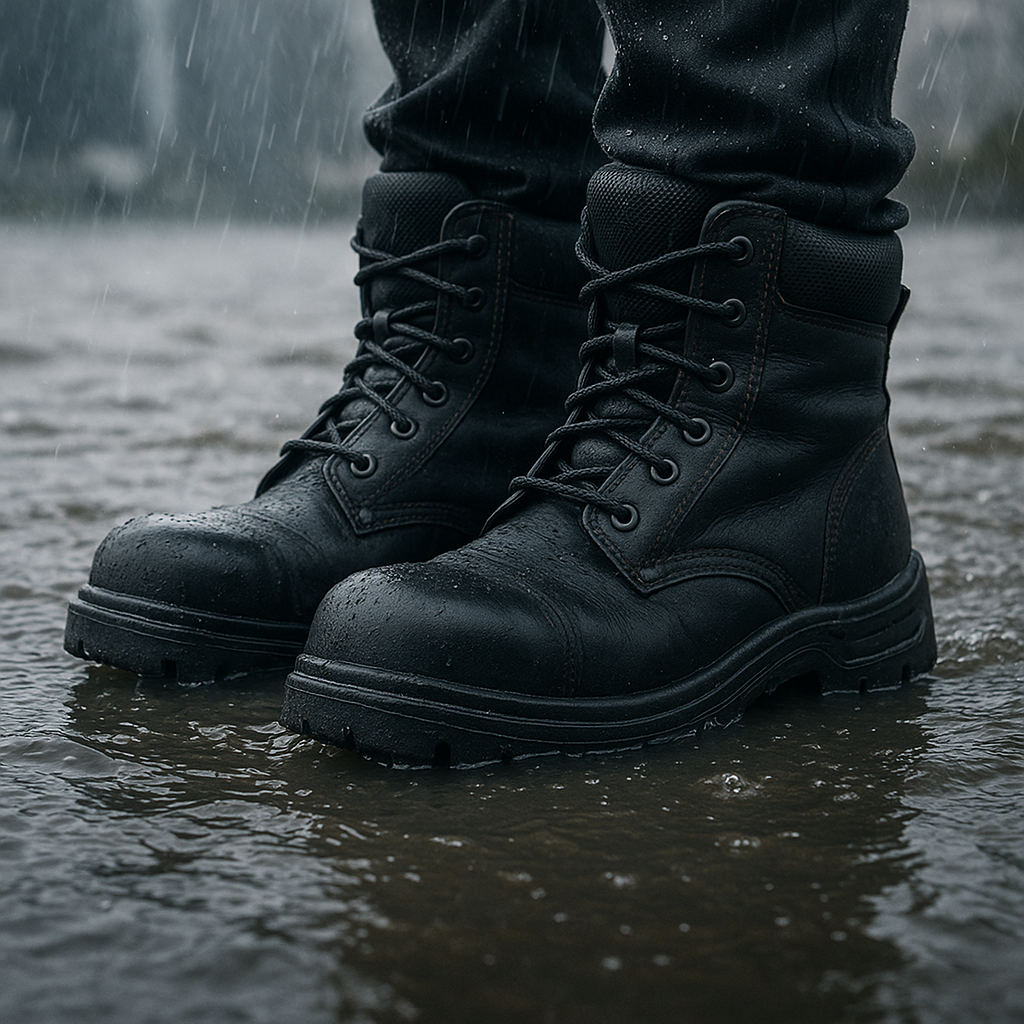When nature strikes with heavy storms and floods, your safety depends on preparation—and that includes your footwear. While sneakers or casual boots might seem fine for everyday rain, they fall short when faced with flooded streets, slippery surfaces, and hidden debris. The best shoes to use in any storm or flood are security boots, thanks to their reinforced protection at the front, waterproof design, and superior grip.
In this article, we’ll break down what makes security boots the top choice, compare them to other footwear, and recommend the best options for storm and flood conditions.
Understanding the Importance of Footwear in Storms and Floods
Why Regular Shoes Fail in Extreme Weather
Most regular shoes—like sneakers, sandals, or casual boots—are not designed for wet and hazardous conditions. They absorb water quickly, lose grip on slippery surfaces, and leave your feet vulnerable to sharp objects floating in floodwater.
Key Features of Storm-Ready Footwear
Storm-ready shoes must include:
-
Waterproof materials to keep feet dry.
-
Slip-resistant soles for traction.
-
Reinforced protection against impact and debris.
-
Durability to withstand extended exposure to water and mud.
What Makes Security Boots the Best Choice?
Security boots stand out in extreme weather because they’re built for protection in hazardous work environments—features that also make them ideal for storms and floods.
Reinforced Front Protection (Toe Caps & Shields)
The steel or composite toe cap ensures your feet stay safe from heavy debris, rocks, or sharp objects often hidden in murky floodwaters.
Slip-Resistant Soles for Wet and Slippery Surfaces
Flood conditions create dangerous surfaces. Security boots use anti-slip rubber soles that grip even on slick pavements and muddy areas.
Waterproof and Water-Resistant Materials
Unlike sneakers or hiking boots, security boots are designed with waterproof leather or treated synthetics that keep water out for hours.
Durability and Longevity in Harsh Conditions
Security boots can withstand constant exposure to mud, chemicals, and water—making them far more reliable than standard rain boots.
Comparing Security Boots with Other Footwear Options
| Footwear Type | Strengths | Weaknesses in Storms/Floods |
|---|---|---|
| Security Boots | Reinforced toe, waterproof, slip-resistant, durable | Heavier than sneakers |
| Rain Boots | Waterproof, lightweight | No front protection, less durable |
| Hiking Boots | Good traction, some waterproofing | Not designed for flood debris |
| Sneakers | Comfortable, lightweight | Soak quickly, slippery, unsafe |
Top Recommended Security Boots for Storms and Floods
Steel-Toe Waterproof Security Boots
Best for maximum protection in dangerous flood conditions.
Composite-Toe Lightweight Security Boots
Offer protection with lighter weight for longer wear.
Insulated Security Boots for Cold and Wet Weather
Perfect for storm-prone regions with cold climates where both warmth and water resistance are essential.
How to Choose the Right Security Boots for Flood-Prone Areas
-
Material Considerations: Rubber and treated leather provide the best waterproofing.
-
Sizing and Comfort: Always allow extra room for thick socks.
-
Certification Standards: Look for ASTM or EN ISO certifications to ensure impact and slip resistance.
Care and Maintenance of Security Boots
-
Cleaning: Rinse boots after exposure to floodwater to remove chemicals and mud.
-
Drying: Air dry away from direct heat to prevent cracking.
-
Waterproofing Treatments: Apply protective sprays regularly.
Safety Tips for Walking in Storm or Flood Conditions
-
Avoiding Electrical Hazards: Never walk near downed power lines.
-
Dealing with Deep Water and Strong Currents: Use a stick for stability; avoid walking if the water is fast-moving.
-
Emergency Preparedness Kit: Always pack waterproof boots along with essentials.
FAQs About Best Shoes for Storms and Floods
Q1. Can I wear sneakers during floods?
No, sneakers absorb water, lose traction, and provide no protection from debris.
Q2. Are rain boots enough for flood safety?
Rain boots keep your feet dry but lack reinforced toe protection and durability.
Q3. Do all security boots have steel toes?
Not always—some use composite toes, which are lighter but still protective.
Q4. How do I keep security boots waterproof?
Regularly apply waterproofing sprays and waxes, especially after cleaning.
Q5. Are security boots comfortable for all-day wear?
Yes, especially modern lightweight designs with cushioning insoles.
Q6. What’s the most important feature for flood footwear?
A combination of waterproofing, slip resistance, and front protection.
Conclusion: Why Security Boots Are the Ultimate Choice
When it comes to surviving storms and floods, the wrong footwear can put you at risk. Security boots provide the perfect blend of waterproofing, traction, and reinforced safety at the front—making them the best shoes to use in any storm or flood. While rain boots or hiking boots have some advantages, none match the all-around protection of security boots.
If you live in a flood-prone area, investing in a pair of high-quality security boots could be one of the best safety decisions you ever make.
🔗 For more details on choosing the right protective footwear, check out OSHA’s footwear protection guidelines.

